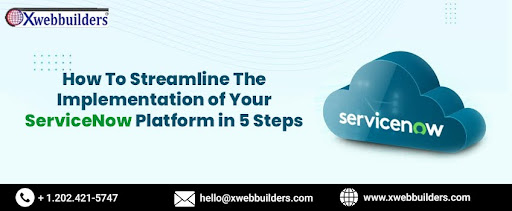
September 01, 2025

Implementing a ServiceNow platform can be a complex undertaking, but with proper planning and execution, organizations can streamline the process and maximize the benefits of this powerful IT service management solution. In this guide, we will outline five key steps to help you streamline the implementation of your ServiceNow platform. By following these steps, you can ensure a smooth and successful implementation, optimize the platform's capabilities, enhance your organization's IT service delivery, and improve overall operational efficiency. From defining your implementation strategy to configuring and testing the platform, this guide by our DBMS and RDBMS software development services USA will provide you with actionable insights to effectively implement and leverage the full potential of your ServiceNow platform.
ServiceNow is a leading cloud-based platform that offers a wide range of IT service management (ITSM) and business process automation (BPA) solutions. It provides organizations with a unified platform to streamline their operations, enhance service delivery, and drive digital transformation. Here is an overview of ServiceNow and its key features:
- IT Service Management (ITSM): ServiceNow's ITSM module enables organizations to automate and optimize their IT service processes. It offers functionalities such as incident management, problem management, change management, asset management, and service catalog, allowing IT teams to efficiently manage and resolve IT-related issues.
- IT Operations Management (ITOM): ServiceNow's ITSM module helps organizations proactively manage their IT infrastructure and operations. It includes capabilities such as event management, configuration management, discovery, and service mapping, allowing IT teams to gain visibility into their infrastructure, troubleshoot issues, and optimize resource utilization.
- IT Business Management (ITBM): ServiceNow's ITBM module provides organizations with tools to align IT initiatives with business goals and strategies. It includes features such as project portfolio management, demand management, resource management, and financial management, enabling organizations to prioritize and execute IT projects effectively.
- Customer Service Management (CSM): ServiceNow's CSM module helps organizations deliver exceptional customer service experiences. It offers functionalities such as case management, self-service portals, knowledge management, and customer satisfaction surveys, allowing organizations to provide timely and personalized support to their customers.
Streamlining the implementation of a ServiceNow platform is essential for organizations looking to optimize their IT service management processes and enhance operational efficiency. By following five easy steps listed by our DBMS RDBMS software development company, you can ensure a smooth and successful implementation of ServiceNow. Let's explore these steps in detail:
Before diving into the implementation process, it's crucial to define a clear strategy. Identify your organization's specific goals, objectives, and requirements for implementing ServiceNow. Determine which modules and features are essential for your organization's IT service management needs. Establish a project plan, including timelines, milestones, and resource allocation. By outlining a well-defined implementation strategy, you can align your implementation efforts with your organization's goals and set the foundation for a successful deployment.
ServiceNow offers a wide range of modules and customization options. Take the time to configure the platform to align with your organization's unique processes and requirements. Tailor ServiceNow's workflows, forms, and automation rules to match your existing IT service management practices. Customize the user interface and design to provide a seamless and intuitive experience for your users. By leveraging the configurability of ServiceNow, you can ensure that the platform aligns perfectly with your organization's needs and workflows.
Data migration is a critical step in implementing ServiceNow. Evaluate your existing data sources and determine the most efficient way to migrate them into ServiceNow. Ensure the integrity and accuracy of the data during the migration process. Additionally, consider integrating ServiceNow with other systems and applications to facilitate data exchange and streamline processes. Integrate ServiceNow with your existing IT infrastructure, such as asset management systems, monitoring tools, and ticketing systems, to create a unified and efficient IT ecosystem.
User adoption is crucial for the success of any new platform implementation. Provide comprehensive training to your IT team and end-users to familiarize them with ServiceNow's features and functionality. Offer hands-on training sessions, webinars, and documentation to ensure that users understand how to leverage the platform effectively. Encourage user feedback and address any concerns or challenges that arise during the training process. By investing in user training and promoting a culture of adoption, you can maximize the value of ServiceNow and empower your team to utilize its full potential.
Thoroughly test the implemented ServiceNow platform to ensure its functionality, performance, and usability. Conduct rigorous testing, including user acceptance testing, to identify and resolve any issues or bugs. Monitor the platform's performance and collect feedback from users to identify areas for improvement. Leverage ServiceNow's reporting and analytics capabilities to gain insights into your IT service management processes and make data-driven decisions for continuous improvement. Regularly review and optimize your implementation, incorporating feedback and adapting to changing business needs.
By following these five steps, organizations can streamline the implementation of their ServiceNow platform, driving operational efficiency and enhancing IT service management processes. A well-planned strategy, customized configuration, seamless data migration and integration, user training, and continuous improvement are key elements to ensure a successful implementation and maximize the value of ServiceNow for your organization.
ServiceNow is a versatile platform with a wide range of applications across various industries. Here are some key areas where ServiceNow can be applied:
- IT Service Management (ITSM): ServiceNow is widely used for IT service management, helping organizations streamline their IT processes, improve service delivery, and enhance customer satisfaction. It offers features such as incident management, problem management, change management, asset management, and service catalog, enabling efficient management of IT services and resources.
- IT Operations Management (ITOM): ServiceNow's ITSM capabilities enable organizations to optimize their IT infrastructure and operations. It includes functionalities like event management, performance analytics, service mapping, and cloud management, allowing IT teams to proactively monitor, troubleshoot, and manage their IT environment.
- IT Business Management (ITBM): ServiceNow's ITSM solutions assist organizations in aligning IT initiatives with business objectives. It covers areas such as project portfolio management, resource management, demand management, and financial management. By leveraging these capabilities, organizations can effectively prioritize and manage IT projects, allocate resources efficiently, and track financial investments.
- Customer Service Management (CSM): ServiceNow offers robust customer service management capabilities, empowering organizations to deliver exceptional customer experiences. It includes features like case management, self-service portals, knowledge management, and omni-channel support. ServiceNow CSM enables organizations to centralize customer interactions, improve response times, and provide personalized and efficient support.
- Custom Applications: ServiceNow's platform allows organizations to develop custom applications tailored to their specific needs. It provides a low-code development environment, allowing users to create custom workflows, forms, and applications without extensive coding knowledge. This flexibility enables organizations to extend the functionality of ServiceNow and address unique business requirements.
In conclusion, streamlining the implementation of a ServiceNow platform is crucial for organizations seeking to optimize their IT service management processes. By following the five steps outlined in this guide - defining the implementation strategy, configuring the platform, migrating and integrating data, training users, and continuous improvement - organizations can ensure a smooth and successful implementation. This streamlined approach enables organizations to maximize the benefits of the ServiceNow platform, enhance operational efficiency, improve service delivery, and align IT initiatives with business objectives. By investing time and effort in a well-planned implementation, organizations can set themselves up for long-term success with ServiceNow. For more information, visit Xwebbuilders.com for contacting experts of DBMS RDBMS Software Development.